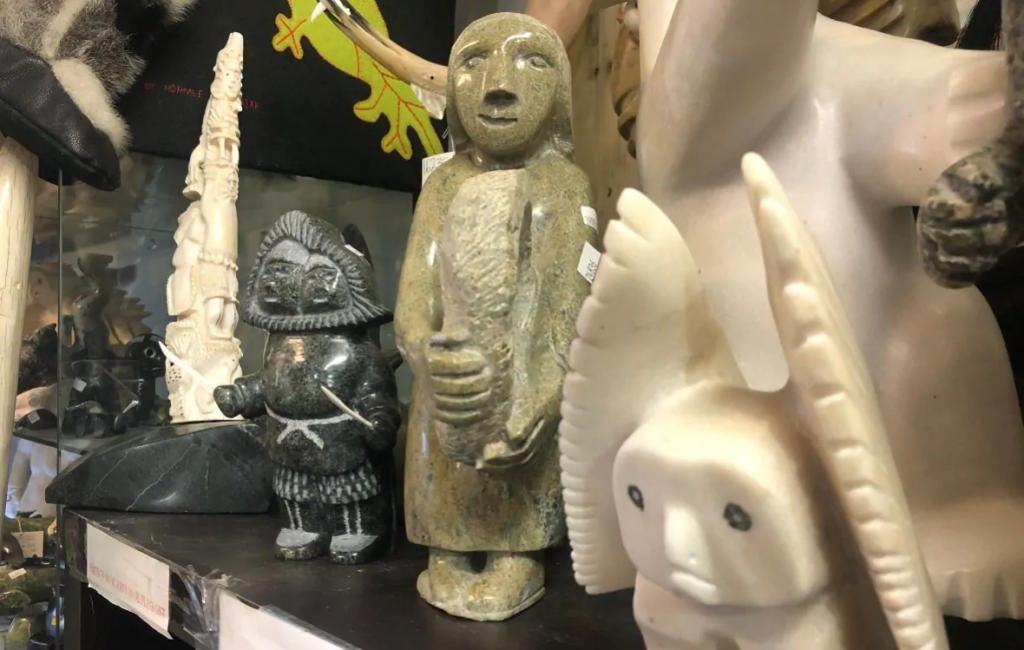Arctic Canada: Nunavut arts and crafts industry enduring … for now

Nunavut’s Inuit art scene is still in decent shape in the face of the COVID-19 pandemic, but those who help bring the artwork to market in the $33 million industry warn the bubble may soon burst.
“Some people are still business as usual and are able to continue to create art and to sell it,” said Janet Brewster, the executive director of the Nunavut Arts and Crafts Association.
“We’re seeing a lot more sales going through social media and I think artists have really been proactive in that.”
Similarly in Kinngait, printmakers are still hard at work on the prestigious Kinngait Studios print collection for later this year.
“The printers here are working daily. They have lots of work to do. They’re pretty busy,” said Joemee Takpaungai, the assistant studio manager at the Kenojuak Cultural Centre and Print Shop.
Although the studio is still buying art from carvers, the shop has seen a 95 per cent drop in sales over the last six weeks with all non-essential travel in Nunavut halted.
“People visiting or people coming up to work with other government departments, they’re our main source of customers. Nobody is buying,” Takpaungai said.

Money running out as bottleneck forms
One of the biggest players in moving Inuit artwork to southern markets is the Nunavut Development Corporation — a crown corporation of the Nunavut Government.
The corporation partners with buyers in Nunavut to go into the communities to buy from artists. Those buyers then sell it to the NDC — whose offices are in Ontario — to be wholesaled in the South. On average, the NDC will buy $60,000 worth of art a month.
One of the NDC’s main buyers is Iqaluit’s Bryan Hellwig, who also sells art through his Northern Collectibles store.
Hellwig has still been buying up art for the NDC in recent weeks. But with the Ontario government ordering all non-essential businesses to close, the NDC hasn’t been able to receive any of the art he’s bought, or pay him for it.
“If I could sum it up in one word: disaster. Inuit art has taken a leap off a cliff in the last month or so. It’s been rough for sure,” said Hellwig, who says he’ll keep up the pace until the money runs out.
“There’s still a bit of retail [sales] still going on from dedicated customers who just want to support the galleries. But it’s certainly nowhere near a normal level.”

Complicating matters is the bottleneck forming by not being able to move artwork. Both because the NDC can’t get to its offices to accept shipments from Nunavut, but also because its clients — galleries, for instance — are also closed and dealing with their own financial constraints amid the pandemic.
“As the shutdowns continue, our clients are going to be affected hugely, which in the long term will affect artists and the whole art industry because the flow of art has stopped,” said Yusun Ha, the general manager of the NDC’s sales division.
“But if this goes on for two more months, our buyers are eventually going to run out of money, and that means they can’t purchase art anymore.”
Financial support available, GN says
For its part, the Nunavut Government pointed to a few pre-existing programs to help small businesses in the territory.
Namely the government’s Small Business Support Program gives up to $5,000 to help with short-term capital costs — although applicants must be a registered business entity, which many artists are not.
There’s also the Community Tourism & Cultural Industries Program which helps with art-related supplies and equipment.

Still, the Nunavut Arts and Craft Association say more needs to be done.
“Aside from being concerned about feeding their families, people are asking whether there’s any way for artists to have some sort of a baseline income through this pandemic,” Brewster said.
While Nunavut’s department of economic development and transportation says there aren’t any plans for guaranteed income programs, artists can reach out to their community economic development officers for help.
“Our best advice to artists right now is try to understand what those supports are,” said deputy minister Bernie MacIsaac.
“Even talking about our small business support and the rationale behind that, that’s there to help people get through this. It’s not there to supplement or replace their income. It’s there to help them will bills. We’re basically in that mode for everybody. We’ll help you get through this.”
Related stories from around the North:
Arctic: Roundup of COVID-19 responses around the Arctic, Eye on the Arctic
Canada: Canadian government providing nearly $130M to help Arctic territories during pandemic, CBC News
Finland: Visits to commercial establishments down sharply in Finnish Lapland, Google data, Yle News
Greenland: COVID-19: Arctic science expedition postpones flight campaign after trainee tests positive for virus, Eye on the Arctic
Norway: Norwegian Arctic wilderness tourism hit particularly hard by coronavirus, The Independent Barents Observer
Russia: Novatek construction site faces fastest growing coronavirus outbreak in northern Russia, The Independent Barents Observer
Sweden: Why Sweden can’t declare a state of emergency over COVID-19, Radio Sweden
United States: Arctic borough pulls out of deal with bankrupt Alaskan airline, reaffirms right to seize assets in emergency, Alaska Public Media



